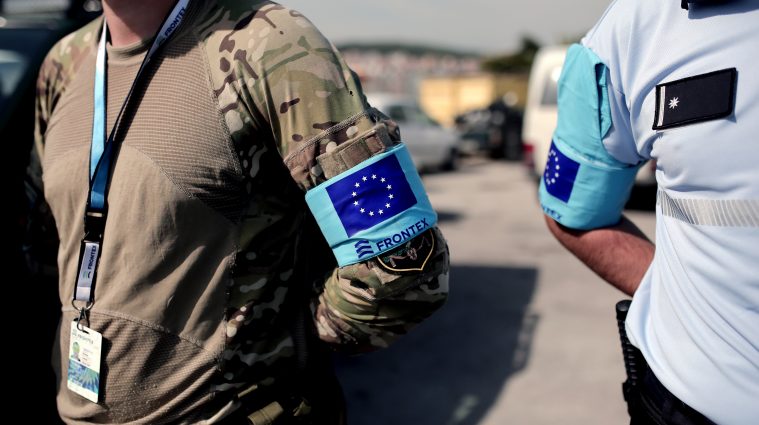Negotiating risks and threats: Securing borders through the lens of intelligence
Intelligence-led policing is intended to support decisions and governance of migration, and make border control more predictable and manageable. Risk analyses produced by Frontex, the European Border and Coast Guard Agency, aim systematically to achieve more efficient border control in tandem with the ‘highest possible standard’ of border policing. The question to be raised is how risk indicators are constructed, and further translated and negotiated in border police practice?
 © European Union, 2015/Source: EC - Audiovisual Service/Photo: Angelos Tzortzinis
© European Union, 2015/Source: EC - Audiovisual Service/Photo: Angelos TzortzinisFrontex’ primary objective was mandated as the improvement of the integrated management of the external borders of Member States of the EU. The aim is prevention, detection and suppression of cross-border crime to combat illegal immigration, people smuggling and trafficking in human beings, in cooperation with agencies such as Interpol and Europol. Since 2016 Frontex does not only collect personal data for Member States, but also for the law enforcement agency Europol.
Human rights and humanitarian ideals are extremely important in the agency’s internal discourse and its self-understanding (Frontex 2016). However, knowledge production within Frontex is more aimed towards managing migration as a security threat than being concerned about knowledge of the vulnerability of migrants. This becomes particularly visible when you look at the risk indicators. The Common Integrated Risk Analysis Model (CIRAM), for instance, presents vulnerability as being determined by the capacity of a system to mitigate a threat (Frontex, 2012: p. 27). Irregular migrants, including those with legitimate protection needs, are therefore first and foremost defined through their risk qualities in the technologies – as threats – rather than through their vulnerability and mortality (Aas and Gundhus 2014; Gundhus 2018). Moreover, risk analysis is framed in the language of state security and consequently, even when addressing migrants’ vulnerability, it tends to conceptualise this using the language of state security and organised crime.

Looking at Frontex officers’ construction of risks on the ground, they have various tasks ranging from border surveillance to fingerprinting and there are registration experts and debriefing experts. However, the law enforcement logic here also obscures migrants’ vulnerability and the humanitarian aspects of the mission. Interviews indicate that collecting data for intelligence processes takes a higher priority than the migrant’s vulnerability. The nature of the police officers’ tasks, in line with the traditional policing ethos, seems to direct their focus towards establishing the truthfulness of the migrants’ stories. Migrants are being ‘screened’ and ‘debriefed’ about their identity, about the facilitators of their journeys, their travel routes, false documents, etc. Migrants are primarily regarded as a source of information to uncover smuggling and other crime-related activities, rather than as people who deserve protection. This might make it difficult for border police to identify risks involving migrants’ vulnerabilities, for example, that they could be victims of trafficking, people with health problems, or unaccompanied minors, and this also has implications for coercive measures in collecting fingerprints and other types of information.
The agency’s knowledge production thus has consequences for its response to the vulnerability of migrants, and for the structural conditions for protecting the right to life at EU external borders. The recent changes regarding the implementation of PeDRA (processing Personal Data for Risk Analysis), the collection of personal data for law enforcement, may strengthen these tendencies. Police resources and sorting processes might, for example, focus even more on the use of coercive measures, rather than on identifying the needs of the vulnerable, and their protection. Although the hotspot approach – interagency collaboration between Europol, EASO and Frontex – aims to improve the reception of refugees and migrants, by identifying, screening and filtering all newly-arrived men, women and children more quickly (European Commission 2015), there has paradoxically been an increased use of coercive measures in registration of identity practices since its introduction (ECRE 2016). Moreover, there has been a general shift towards the use of more coercive measures in relation to registration and identity checking, and the acquisition of biometric data to stop refugees and migrants passing through Italy and Greece to seek asylum in other countries.
Despite the importance of fundamental rights, it can therefore be argued that the structure of the risk discourse in Frontex reveals the disjunction between state security and human security. The agency’s knowledge production has consequences for its practical responses to migrant vulnerability and mortality, and for the structural conditions for protecting the right to life at the EU’s external borders. Moreover, the portrayal of the current wave of mass migration as a crisis legitimises not only increased external and intra-Schengen control and different securitisation efforts, but also the growing merging of crime control and immigration control: migration and cross-border strategies are bundled as one. If insecure identities are seen as dangerous, this to a certain extent opens the way for the use of more coercive methods to secure them; a process that has been described as the criminalisation of identity (Aas 2013).
Controlling migration as a future risk also connects crime and terrorism in ways that may label migrants and asylum seekers as potential criminals or terrorists. The dominating concern for border pressure and vulnerability, and the absence of risk identification of special needs and for protection observed when the hotspot approach is examined, suggests that it carries important risks for migrants, and that there are ‘requirements for additional safeguards and rigorous monitoring in order to ensure its full compliance with obligations under international human right law and the EU asylum acquis’ (ECRE 2016: 9). The question can therefore be raised whether the failure to record and deal with migrants’ vulnerability leads to certain forms of inaction, and if so, what the consequences are.
Sources
Aas, K. (2013) ‘The ordered and the bordered Society: migration control, citizenship and the northern penal state’, in K. F. Aas and M. Bosworth (eds) The Borders of Punishment: Migration, Citizenship, and Social Exclusion, Oxford: Oxford University Press.
Aas, K. Franko and Gundhus, H. O. I. (2014) ‘Policing Humanitarian Borderlands: Frontex, Human Rights and the Precariousness of Life’, British Journal of Criminology, 55: 1–18, doi:10.1093/bjc/azu086.
Frontex (2012b) Guidelines for Risk Analysis Units. Structure and Tools for the Application of CIRAM Version 2.0, Warsaw: Frontex.
Frontex (2016) Annual Information on the Commitments of the Member States to the European Border Guard Teams and the Technical Equipment Pool. Report 2015, Warsaw: Frontex, (accessed 19 November 2017).
ECRE (2016) The implementation of the hotspots in Italy and Greece. A Study. The European Council for Refugees and Exiles. (accessed 19 November 2017).
European Commission (2015) A European Border and Coast Guard to protect Europe's External Borders. (accessed 19 November 2017).
Gundhus, H.O.I (2018) Negotiating risks and threats: Securing the border through the lens of intelligence, in Fyfe, N, Gundhus, H.O.I og Rønn, K.V. (eds), Moral issues in Intelligence-led policing. London: Routledge.


